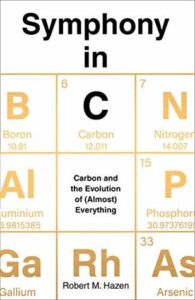 Symphony in C, Robert M. Hazen
Symphony in C, Robert M. Hazen
Honestly, I could’ve picked this up just for the title, which I thought was clever. But of course, carbon is an intensely important element for life, so it ties in very much with my interest in biology — no carbon, no us! — and it didn’t seem like it’d be too far off the random path of my current interests. Which proved to be mostly true: I found it harder going than a book about biology, my preferred science, but Hazen’s enthusiasm for his subject carried me along to a great extent.
Often enthusiasm gives life to writing, but I did find that there were bits of this I got a bit stuck on just through not getting involved enough… and knowing that e.g. Richard Fortey can get me excited about rocks with the way he writes, that I do put down to a certain dryness in the writing. Oddly enough, it was the parts on biology I yawned through; I don’t need the facts to be new to me, but if you’re explaining to me about why carbon is the ideal element for life, I need you to make it more exciting than my textbook. (This may not be fair, as I find certain aspects of my textbooks very exciting. The membrane attack complex is a marvel! No, friends who have been subject to me exclaiming about the MAC — I’m not over it yet! Biology is amazing!)
Anyway, if you’re interested in carbon, in the history of how we understand carbon as well as the current state of the field, it’s not a bad read. It’s lacking in tables and images that can really talk people through the data rather than just explaining like a story, so it’s very pop-science in that sense, so I’m not sure how much of it will stick for me. The symphony conceit got old for me/didn’t always feel like the right way to balance/organise the material, but I learned some new things and cemented some others in my mind, and really, that’s all I ask.

Leave a Reply